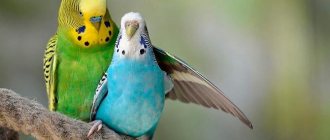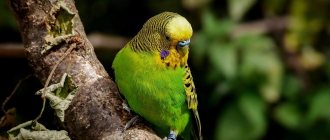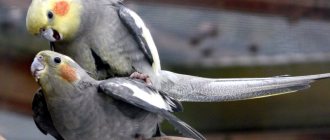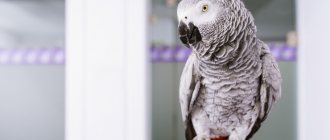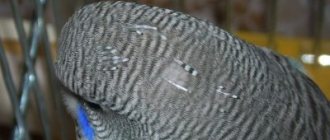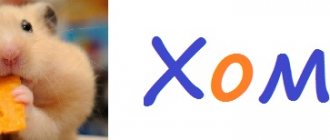The yellow parrot photo, which can be seen on our website, has long created competition for the traditional green wavy fidget. And despite the fact that over the past hundred years many different shade variations have been developed in the world. It is yellow budgies that are most desirable for most breeders of small exotic pets.
Birds with red plumage are much less common. By and large, they are considered even rare.
In addition to the mentioned yellow and green colors, there are birds with white feathers. However, among the successful color variations it is worth highlighting blue. In fact, it is a kind of noble color, well suited even for such a small bird as a budgerigar. However, we will not deviate from the main topic and will tell you in more detail about yellow parrots.
Description
The natural color of the budgerigar is green with a yellow head, blue tail and a black wave-like pattern on the back, head and wings. Two pigments are responsible for the formation of color: black (eumelanin) and yellow (psittacin). Yellow color, due to the presence of psittacin in feathers, is the main (basic) color. Superimposed on it is blue, which results from the sparse distribution of eumelanin granules in feathers. When these two colors are superimposed on each other, the result is green.
In yellow budgerigars, eumelanin is absent or its amount is reduced to a minimum. Disturbances in the deposition of melanin in feathers can be caused by mutations of various genes. Depending on this, there are 3 types of yellow budgies:
- dark-eyed pure yellow;
- two-factor yellow spangles;
- lutino (ino mutation).
These varieties look almost the same, but have completely different sets of genes.
In dark-eyed pure parrots, the color is due to a combination of two mutations: recessive variegated and pure variegated. Alone, these two mutations cause partial leucism; in combination with each other they give a completely leucistic color. The plumage of dark-eyed pure yellow parrots is light yellow; uniform color throughout the body. The primary flight and tail feathers are paler. The cheek spots (two small spots located on the cheeks on either side of the beak) are white (they are blue in wild parrots). The eyes are dark. Legs intense pink.
The spangle gene is responsible for changing the order of distribution of pigment granules in feather structures and reducing melanin deposition. This mutation is also characterized by the presence of a recessive modifier, which is a lightening factor. When two Spangles are crossed, the offspring produces chicks that carry the Spangle gene from both parents—two-factor Spangles. They have less melanin in their feathers than single-factor feathers (i.e. those obtained from crossing a Spangle and a non-Spangle). This is due to the fact that the spangle gene has incomplete dominance over the corresponding standard gene. Therefore, in one-factor spangles the dark pattern is partially retained and a blue or green color is present, while in two-factor spangles the color becomes monochromatic, without a pattern or color inclusions. The plumage of two-factor yellow spangles is pure yellow; the primary flight and tail feathers are slightly lighter. The spots on the cheeks are white with a silvery tint. The pupils are black, the iris is white. The legs are bluish-gray, deep pink, or a shade somewhere between these two colors.
The ino gene causes the production of eumelanin to cease. In addition, this gene masks all other mutations (except cinnamon). Therefore, birds with the ino mutation lack the black pattern, blue and green spots, and the pupils are red. The lutino parrot is an intense, uniform yellow color. The primary flight and tail feathers are white or yellowish-white. The cheek markings are white. The pupils are red, the iris is white. Paws are pink. The ino gene is sex-linked and is located on the X chromosome. Since birds have a set of sex chromosomes in females - XY, and in males - XX, outwardly the ino mutation appears more often in females, and males can be carriers and do not differ in appearance from normal parrots. Lutino males can only be produced by crossing two parents carrying the ino gene.
Key points about keeping parrots at home
Corellas do not require special living conditions. The basic rules for living such a parrot are good and proper care and feeding.
Find out what colors cockatiels come in, how to choose a cockatiel, how to care for it and its chicks at home.
Cell
The cage requirements are:
- Birds of this species do not like cramped conditions, so the place for their housing should be spacious.
- The cage must be vertical with minimum dimensions for one bird of at least 60x50x50 cm, and for a pair - 150x70x70 cm.
- It is better to opt for a cage made of steel without varnish or paint. The distance between the rods should be less than 2 cm.
- It is recommended to choose a place for the cage away from drafts and cool air, since this is a heat-loving bird. Corellas do not like changes in air, and the optimal temperature for keeping them is +22…+24 °C. When turning on the heaters in winter, it is necessary to additionally humidify the air.
- Cleaning the cage should be done regularly: changing the tray filler, washing the drinking bowl, feeder, and toys every week.
Accessories
Cockatiels are active and love to frolic, so it’s worth decorating their home with accessories such as:
- 2-3 feeders if there are several birds. The diameter of the feeder should be 6–7 cm, which will allow the bird to feed freely and comfortably;
- the drinker should also have a large hole diameter, which will provide free access to water and make it possible to wash it efficiently;
- toys: ladders, perches, swings, mirror, rings, ropes.
In a spacious cage you can place at least 2-3 perches, for which you can use twigs with bark with a diameter of 2-2.5 cm. It is better to use branches of fruit trees.
Find out if it is possible to make drinking bowls, feeders, and toys for parrots.
It would not be a bad idea to provide the lutino with the opportunity to swim by placing a special bath of water or a deep container with a small amount of liquid in the cage. The bird can be sprayed with a spray bottle or even bathed in the shower.
Corellas are very playful, so they will not refuse toys, swings, and bells. However, you should consider their placement in the cage so that they do not interfere with the bird’s flight.
Feed and water
The cockatiel's diet should be varied, although the birds are not picky or demanding when it comes to food.
First of all, these should be:
- grain mash , which should include millet, sunflower seeds, oats, wheat, canary seed, corn, flaxseed, crushed nuts;
- herbal supplements: chicory, dandelion leaves, twigs that will help cleanse the beak;
- vegetables: carrots, cauliflower, broccoli, Brussels sprouts, beets and cucumber;
- fruits: apple, pear, apricot, peach, plum, cherry, quince, bananas, melon, pineapple, kiwi, mango, oranges.
Corella birds can be fed with special balanced feed mixtures, which are sold at any pet store.
Important! The water in the drinking bowl should always be fresh - the key to the health and activity of the cockatiel.
The following should not be given to cockatiels as food:
- candied fruits and vegetables;
- dairy and fermented milk products;
- roast;
- salty;
- parsley;
- dill;
- cilantro;
- mint.
Determination of gender
Determining the sex of yellow budgies can be difficult. This is due to the fact that the melanin content in birds of this color is reduced not only in the feathers, but also in the cere, as a result of which the cere of males and females can have almost the same color. To reliably determine the sex of young birds, a laboratory DNA analysis is performed. In birds older than two years of age, the shades of the cere of males and females begin to differ.
Thus, in dark-eyed pure yellow parrots, as well as representatives of the lutino morph, the cere of males has a pure pink tint, and that of females is brownish. Male two-factor yellow spangles have a blue cere, while females have a brown cere.
How to breed feathered friends
One traveler from England made a note about an unusual species of birds that lived in Australia, this was in 1805. After this note, more and more facts became known about this exotic bird, and demand for them began to appear. Many tried to bring this type of bird to Europe, but the result was sad; the birds died during transportation.
Some still managed to smuggle in a parrot, and they became feathered pets. Later, budgerigars became a common type of pet, and breeders began to conduct experiments. Thanks to experiments, more than 200 species of feathered friends were bred, which had different colors, different patterns and different shapes of wings. Each species was individual and completely different from other species.
But, unfortunately, when the breeder was chasing the unique appearance of the parrot, it became known that through selective breeding, parrots acquire a weak immune system. Despite this sad nuance, demand did not lose momentum. The budgerigar, yellow in color, was also bred through selective breeding. What makes it unique is that it does not have a black pigment.
Pale yellow variety
The yellowface gene is responsible for the yellowish color of the head of wild budgerigars. If the plumage on a bird's body lacks the yellow pigment psittacin, it turns blue. If the black pigment eumelanin is also absent, the bird acquires a pure white color. This morph is called "albino". When the yellowface gene is present, an albino parrot's plumage becomes pale yellow. These yellow parrots are called “yellow-faced albino.”
The plumage of yellow-faced albino is unevenly colored. The most intense color is observed on the head (mask area). The rest of the body is painted paler. The coloring is often uneven: light and even whitish feathers alternate with brighter ones in a chaotic manner.
Habitat
There is a yellow parrot in Australia. The mainland is quite wooded, which is why parrots are usually green in color. This helps them camouflage themselves from predators.
However, for the same camouflage purposes, their color is not uniform. There are splashes of white, yellow, and blue. There is also a black color on the feathers of birds, which helps them blend in with the branches.
Thus, the colors help small nimble birds to successfully exist in the conditions of Australian forests and jungles.
In the morning and late evening, lutinos look for food. Towards the zenith of the Sun, they gather in large flocks and sit on the crowns of tropical trees. This is how all their hot days pass in their native land. The owner of a tropical bird does not have to adjust its care regimen to the natural habit of the bird.
Parrots feel no less good in cozy cages with a sea of toys, tasty food, fresh water and a caring owner nearby.
Additional photos
The photographs show, in descending order, the following varieties of budgies: another crested, harlequin (the color is differentiated on the chest and tummy), lutinous (it has yellow feathers without a pattern), fallow (distinguished by the red color of the eyes), brown-winged (theirs are not so bright plumage color, like cinnamon), mottled, anthracite, slate, sky blue misty (from English “fuzzy”, “unclear”), celandine, curly, lace wing (have “lace wings”), black-faced, gray, black, yellow-faced blue spangle, turquoise and light blue budgie girl.
Breeding and selection
Exotic birds living in Australia became known back in 1805. One English traveler noticed handsome parrots on the branches of tropical trees on the mainland, described them and included them in his reviews.
Since then, taking birds outside their usual habitat has been an impossible mission - often the birds were driven to death either by transportation, or by the conditions of another land, or the climate of an unknown area. Only rich people who were willing to pay a lot of money to create comfortable conditions for the bird’s existence were able to keep their feathered pets alive.
Later, people still managed to adapt to observing the rules for keeping lutino parrots. Modern poultry houses successfully keep them as pets in apartments and houses. Today's parrots have become so used to it that they can't handle living conditions indoors. Moreover, they do not require special heating or lighting. They have become absolutely unpretentious.
Some bird lovers even breed lutino. With the right approach, you can get good money for chicks.
To start breeding parrots, you need to consider:
- There must be a male and a female in the cage. It is quite easy to guess the sex of birds; DNA analysis will help you determine this parameter most accurately. It is carried out in veterinary clinics.
- Not all birds are capable of reproduction and not all desire it. We need strong and resilient individuals who show sympathy for each other. Parrots are surprisingly faithful birds, which is why sympathy is the main parameter of a “happy married couple.”
- There should be some periodicity between bird breedings. Too frequent matings can “disable” a couple.
For breeding, you also need to know the rules for caring for chicks. Parrot chicks require special care, because nature dictates that they are raised in hot climates.
It is important to consider that selective breeding does not promise much success. The reason for this is the usual rules of genetics. Birds become more and more immune-weak with each generation, and the likelihood of death is high. From time to time it is necessary to change males/females with individuals obtained from a “different genus” of birds.


